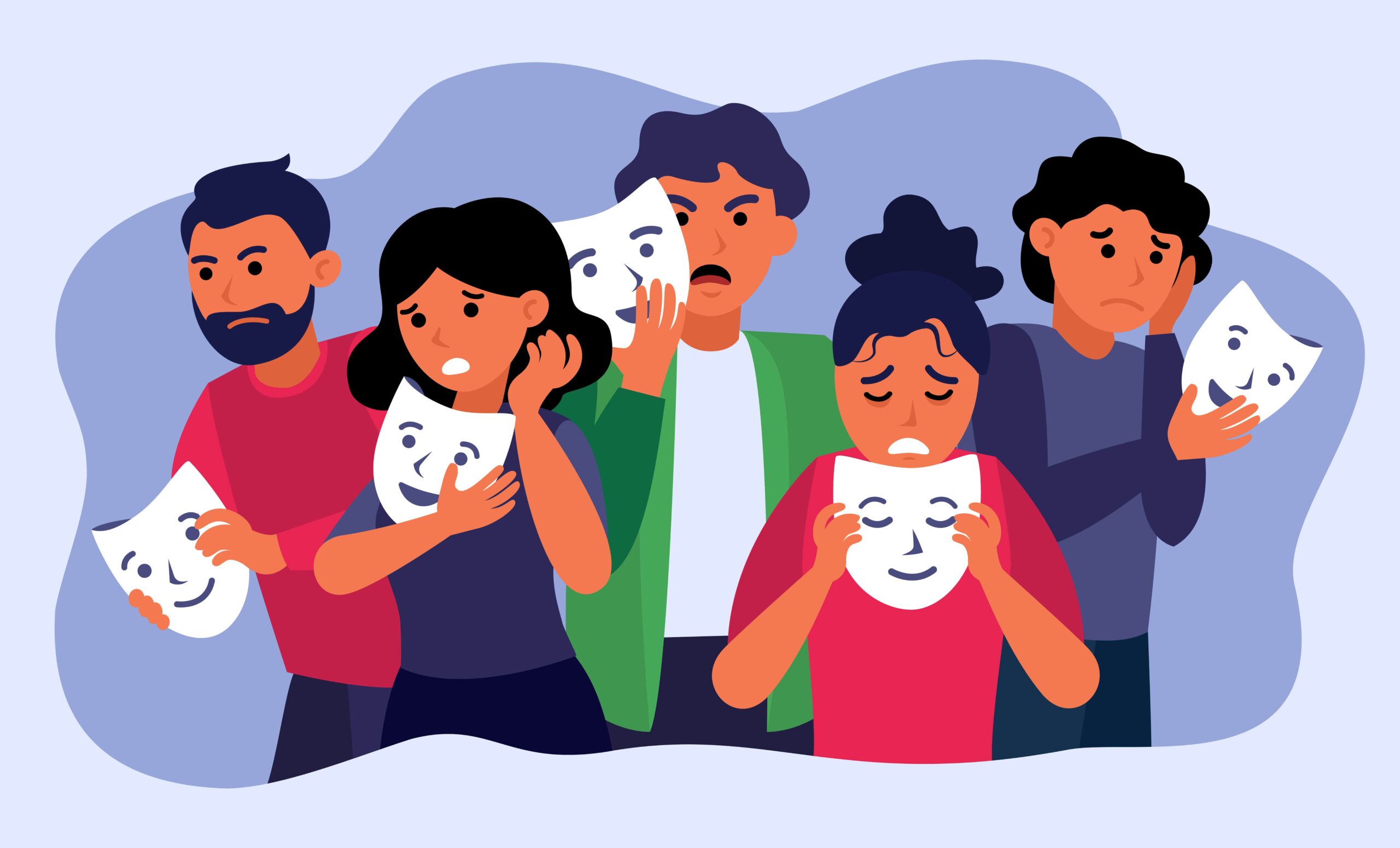Depression
If it is not you, you have probably met someone who is struggling with depression.
Depression also known as (Major depressive disorder) is a psychological condition that frequently affects the way you feel, think, and behave. It is considered to be a serious medical condition since it may lead to emotional and physical problems. Moreover, it interferes doing normal daily activities.
So, let’s figure out, what is depression. what are the main symptoms and types?
Being depressed is not shameful
Any person may experience depression. Low self-esteem and anxiety have been linked to it, having the impression that you never perform well. You could think that enjoying the moment is impossible or improper. If you don’t express these emotions, they will consume you from the inside out.
Symptoms and signs of being depressed or having depression
Sadness and/or a loss of interest in previous hobbies are symptoms of depression. It can impair your ability to perform at work and at home and cause several mental and physical issues.
From moderate to severe, signs of depression might include:
- Sad or in a dismal frame of mind
- losing interest or enjoyment in once-enjoyed activities
- Modifications in appetite, including weight loss or increase unrelated to diets
- Sleep disorders, such as insomnia or excessive sleeping
- A decrease in energy or more weariness
- Increased unintentional movement (such as pacing, hand-wringing, or inability to sit still) or delayed speech or movement (these actions must be severe enough to be observable by others)
- Feeling unworthy or guilty
- Difficulty with decision-making, concentration, or thinking
- Emptiness, or a sense of futility
- Irrational behavior, irritation, or frustration, especially about trivial issues
- loss of enjoyment or interest in the majority of everyday activities, including sex, hobbies, and sports
- Due to fatigue and a lack of energy, even simple tasks need more effort.
- The feeling of unease, anxiety, or worry
- Sluggish speech, posture, or other body movements
- Feelings of a fixation on mistakes made in the past, or self-blame
- Problems with memory, and thought
- Thoughts of suicide, death, or other suicidal behavior on a regular basis or repeatedly
- Undiagnosed physical issues like headaches or back pain
For a diagnosis of depression, symptoms must persist for at least two weeks and must indicate a change from your pre-existing level of functioning.
According to research, depression is thought to afflict one in 15 adults (6.7%). In addition, 16.6% of the population will experience depression at some point in their lives. Although it can strike at any moment, depression typically first manifests itself in late adolescence to mid-life.
Depression is more common in women than in males. According to some research, one-third of women will go through a significant depressive episode at some point in their lives. When first-degree relatives (parents, children, or siblings) also have depression, there is a significant degree of heritability (about 40%).
Depression in children and adolescents
Although there may be some distinctions, the typical signs and symptoms of depression in adolescents and teenagers are comparable to those in adults.
Depression in young children might manifest as melancholy, impatience, clinginess, concern, aches, and pains, refusal to attend school, or being underweight.
Teens may experience symptoms such as:
- Sadness
- Irritability
- Feeling down and unworthy
- Anger
- Poor performance or poor attendance at school
- Feeling misunderstood and overly sensitive
- Using alcohol or drugs recreationally
- Eating excessively
- Engaging in self-harm
- losing interest in regular activities
- avoiding social interaction
Depression in adults
Depression is never to be taken lightly because it is not a typical aspect of aging. Unfortunately, older persons with depression frequently go undetected and untreated, and they may be hesitant to get assistance.
Adult persons may experience various or less noticeable signs of depression, such as:
- Memory issues or personality alterations
- Physical discomfort
- Symptoms of exhaustion, anorexia, insomnia, or loss of desire for sex that is not brought on by a disease or medication
- Frequently preferring to stay in rather than leave the house to interact with others or try new things
- Especially with elderly men, suicidal thoughts or feelings
Various types of depression

It’s critical to understand the many types of depression and the one you are experiencing in order to choose the best course of treatment.
1- Major Depressive Disorder (MDD)
A person with major depressive disorder (MDD) has the majority of the symptoms listed below for longer than two weeks:
- low mood
- lack of interest in previously pleasant activities (known as anhedonia)
- Gaining or losing weight
- Sleep changes Fatigue
- Feelings of remorse, sorrow, and worthlessness
- Difficulty concentrating
- Suicidal thoughts
2- Persistent Depressive Disorder (Dysthymia)
A mild, protracted form of depression is called dysthymia (persistent depressive disorder).
Less serious symptoms than those experienced by MDD patients are those of dysthymia sufferers.
The main distinction is that they go through these symptoms for two years or more. Dysthymia leaves you perpetually “depressed.”
You might not be aware that you have dysthymia due to how long-lasting the symptoms are and the little of a negative influence they may have on your life.
You might believe that way you’ve been feeling is typical.
Treatment for dysthymia may include a mix of the following:
- firstly, Psychotherapy
- Secondly, TMS therapy
- Thirdly, medicine that fights depression
Lifestyle adjustments, such as better eating habits, regular exercise, and sound sleep
3- bipolar disorder (Manic Depression)
people with bipolar disorder suffer (Manic Depression) periods of unusually heightened mood (mania) and depressive episodes back-to-back.
Hypomania is the term used when manic episodes are particularly severe.
This may have a huge effect on how you function every day.
Hypomania often can lead to hospitalization and impair your ability to maintain reality. On the other side, hypomania is a milder variety of mania.
You could experience severe euphoria when experiencing the manic phase of bipolar disorder. It is typical to have the following:
- Lots of vigor
- Wild notions
- Ambivalent plans
4- Psychotic Depression (Depressive Psychosis)
A person who is depressed and has psychosis is said to have psychotic depression. When this happens, you are experiencing psychosis. Psychotic symptoms include:
- Delusions (mistaken beliefs and sensations)
- Hallucinations (seeing or hearing things that aren’t real)
- Anxiety
- Agitation
- Confusion
- Paranoia
- Unorganized speech and thinking, as seen by the sporadically switching themes
5- Postpartum Depression (Intense baby blues)
Some mothers experience postpartum depression after giving birth. Although it’s more severe than the blues, you may have heard it referred to as “baby blues.”
Significant hormonal changes during pregnancy have been associated with this type of depression.
Your levels of progesterone and estrogen decline sharply after giving birth.
Your brain may change as a result, which may cause significant mood fluctuations. When caring for newborns, many mothers frequently experience sleep loss, and lack of sleep can make depression symptoms worse. Constant fatigue, melancholy, and loss of energy are possible symptoms of the illness.
Postpartum psychosis, a mental illness in which depression is followed by confusion, hallucinations, or delusions, can also affect new moms.
You can lessen the symptoms of postpartum depression by making lifestyle adjustments. Effective tactics could consist of:
- Getting sufficient rest
- Scheduling physical exercise
- Using a network of family and friends to provide support
- Frequent, nutritious meals
- Requesting that someone watch your child
6- Seasonal Affective Disorder (SAD, winter blues)
A form of depression known as seasonal affective disorder (SAD) has a seasonal rhythm. Winter is when most people feel SAD, commonly known as “winter depression.”
Others report regular wintertime moods but depressive summertime ones. Lack of vitamin D, which your body uses to make when exposed to sunlight, has been related to the mood changes associated with SAD.
Some SAD, winter blues sufferers discover that light treatment lessens their symptoms. Sitting next to a lightbox, a particular type of lamp is part of the light therapy process. This encourages vitamin D3 synthesis.
Light therapy can have the following negative effects:
- Irritability
- Having Headaches
- Eyestrain
- Feeling tired and exhausted
- Blurred vision
Starting TMS therapy prior to the season in which you experience depression can help you through a challenging time of year with a positive outlook and a plan for overcoming SAD.
7- adjustment disorder
A traumatic or stressful event may result in adjustment disorder cases.
Symptoms include:
- sadness
- A bad attitude
- Crying a lot
- Anxiety
- Stomachaches
- Headaches
- Heart palpitations
- Changes in appetite
- Weight gain or loss
- Exhaustion
- Unusual recklessness
- Unusual destructive behavior
- Drug or alcohol misuse
- Isolation
8- Melancholic Depression
Genetics and chemical abnormalities in the brain are two potential causes of melancholic depression.
Symptoms include:
- low mood
- Feelings of emptiness
- Not being able to identify a purpose in life
- Change in appetite; significant weight loss or gain
- Waking up too early
- excessive guilt
- Difficulty initiating
- Difficulty performing routine or menial tasks
- Cognitive and physical slowness
- Poor concentration
- Physical agitation
- Hypersomnia
9- Atypical Depression
Genetics, traumatic or stressful life events, drug or alcohol misuse, and isolation are among possible causes.
Symptoms include:
- The poor mood is the mood that is frequently and significantly influenced by ambient and situational conditions
- Greater sensitivity to rejection
- Difficulties forming and maintaining social connections
- Insomnia
- Hypersomnia
- Overeating
- weight gain
- In addition to feeling exhaustion or weakness
10- Premenstrual Dysphoric Disorder
Low serotonin levels may be the cause (neurotransmitters in the brain that control mood, attention, sleep, and pain)
Symptoms are:
- Anxiety
- Feeling out of control
- Mood swings
- Food cravings
- Binge eating,
- Panic attacks
- Irritability
- Anger
- Bloating
- Breast tenderness
- Headaches
- Joint and/or muscle pain
- Difficulty sleeping
- loss of interest in relationships and daily activities
- Moreover, fatigue, sadness, and feelings of hopelessness.
Although your description of depression is particular to you, it probably fits into one of these categories.
The first and most important step in developing a successful treatment plan is to comprehend how the types differ in terms of their causes and symptoms.
When it is necessary to visit the doctor?
Make a quick appointment with your doctor or a mental health expert if you’re feeling depressed for more than two weeks. Talk to a friend or loved one, a health care provider, a member of your faith, or another someone you trust if you’re hesitant to get help.
References and resources: NHS, MAYO CLINIC, Cleveland Clinic, webMD. WHO.


Leave a Reply